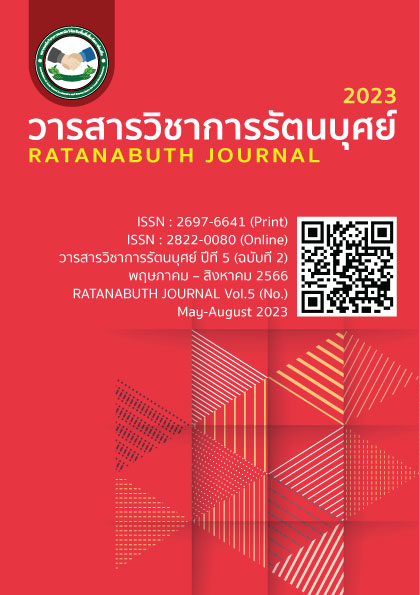The Development of Learning Activities using Constructivism to Promote Creative A Good Citizenship to The Way of Democracy in Social Studies Subject of Mathayomsuksa 3 Students The Development of Learning Activities using Constructivism to Promote Creative A Good Citizenship to The Way of Democracy in Social Studies Subject of Mathayomsuksa 3 Students
Main Article Content
Abstract
The purpose of this research is to 1) Create and check the quality of learning activities using constructivism to promote creativity, a good citizenship to the way of democracy in social studies subject 6 of mathayomsuksa 3 students. 2) Study the results of learning activities using constructivism to promote creativity, a good citizenship to the way of democracy in social studies subject 6 of mathayomsuksa 3 students with 70 percent. The research method was divided into 2 steps, steps: 1 create and check the quality of learning activities using constructivism to promote creativity, steps: 2 Study the results of learning activities using constructivism to compare creativity of mathayomsuksa 3 students after learning activities using constructivism with 70 percent. The sample consisted of 24 mathayomsuksa 3 students from 4 classrooms, Implement activities for 7 weeks, the data were analyzed using t-test (one sample), mean ( ) and standard deviation (S.D.)
The research results showed that:
- learning activities using constructivism to promote creativity according background, principle, objective, content, structure, measurement and evaluation. The overall quality assessment results of learning activities were appropriate at the highest level.
- Students' creativity after learning was higher than the criteria of 70 percent with statistical significance at the .05 level and students were satisfied with learning activities using creative theory at the highest level.
Article Details

This work is licensed under a Creative Commons Attribution-NonCommercial-NoDerivatives 4.0 International License.
References
กรมวิชาการ. (2545). หลักสูตรการศึกษาขั้นพื้นฐาน พุทธศักราช 2545. กรุงเทพมหานคร : องค์การรับส่งสินค้าและพัสดุภัณฑ์.
กันยารัตน์ นิลภา. (2565). การพัฒนากิจกรรมการเรียนแบบรับใช้สังคมที่เสริมสร้างความเป็นพลเมืองตื่นรู้ ด้านการเป็นพลเมืองมีส่วนร่วมของนักเรียนชั้นประถมศึกษาปีที่ 6. Journal of Roi Kaensarn Academi,8(1),177-196.
ธัญญาพร ก่องขันธ์. (2553). ผลการพัฒนากิจกรรมการเรียนรู้ เรื่องการอนุรักษ์ทรัพยากรธรรมชาติ กลุ่มสาระการเรียนรู้ สังคมศึกษา ศาสนา และวัฒนธรรม โดยใช้การจัดกิจกรรมการเรียนรู้แบบ 4MAT ที่มีต่อผลสัมฤทธิ์ทางการเรียน และความคิดสร้างสรรค์ของนักเรียนชั้นประถมศึกษาปีที่ 5 โรงเรียนบ้านโคกม่วง. วารสารศึกษาศาสตร์ คณะศึกษาศาสตร์มหาวิทยาลัยขอนแก่น, 4(5)(2010): ฉบับพิเศษ 2553,182-192.
พิมพ์ชนก แพงไตร. (2558). การพัฒนากิจกรรมการเรียนรู้ด้วยกระบวนการคิดแก้ปัญหาอนาคตตามแนวคิดทอแรนซ์ เรื่อง อาหารและการดำรงชีวิตเพื่อส่งเสริมความคิดสร้างสรรค์ สำหรับนักเรียนชั้นมัธยมศึกษาชั้นปีที่ 2. การศึกษาค้นคว้าด้วยตนเองหลักสูตรปริญญา (สาขาวิชาหลักสูตรและการสอน). การศึกษามหาบัณฑิต มหาวิทยาลัยนเรศวร.
มณีรัตน์ ศุภานุสนธิ์. (2551). การสอนสังคมศึกษา.สืบค้นเมื่อ 9 พฤษภาคม 2564 จาก: https://www.gotoknow.org/posts/117433.
โรงเรียนวิทยาศาสตร์จุฬาภรณราชวิทยาลัยพิษณุโลก. (2561). รายงานการประเมินมาตรฐานการศึกษาของโรงเรียนวิทยาศาสตร์จุฬาภรณราชวิทยาลัยพิษณุโลก. งานประกันคุณภาพโรงเรียนวิทยาศาสตร์จุฬาภรณราชวิทยาลัยพิษณุโลก
หัตถยา เคราะห์ดี. (2558). การพัฒนาทักษะความคิดสร้างสรรค์และผลสัมฤทธิ์ทางการเรียนด้วยกระบวนการสอน Synectics รายวิชา ส 23102 สังคมศึกษา สำหรับนักเรียนชั้นมัธยมศึกษาปีที่ 3. วารสารศึกษาศาสตร์ ฉบับวิจัยบัณฑิตศึกษา มหาวิทยาลัยขอนแก่น, 11(4),243-253.
De Bono, Edward. 1982. Lateral Thinking : A Text book of Creativity. Harondswort : Penquin Book.
Driscoll, Marcy. (2000). Psychology of Learning for Instruction. Boston: Allyn& Bacon.
Hooper, D. , Coughlan, J. , & Mullen, M. (2008). Structural Equation Modeling: Guidelines for Determining Model Fit. Electronic Journal of Business Research Methods, 6(1), 53-60.
Piazza, G. A., Rahm, A. L. K., Krutzsch, M., Sperl, G., Paranka, N. S., Gross, P. H. & Ahnen, D. J. (1995). Antineoplastic drugs sulindac sulfide and sulfone inhibit cell growth by inducing apoptosis. Cancer research, 55(14), 3110-3116.
Thorndike, Edward L. (1966).Human learning. Cambridge, Mass. : M.I.T. Press.
Torrance.(1973). Is Creativity Teachable ?. Bloomington : Kappa Educationnal Foundation.
Torrance, E. P. (1966). Torrance tests of creative thinking: Norms-technical manual: Verbal tests, forms a and b: Figural tests, forms a and b. Personal Press, Incorporated.


